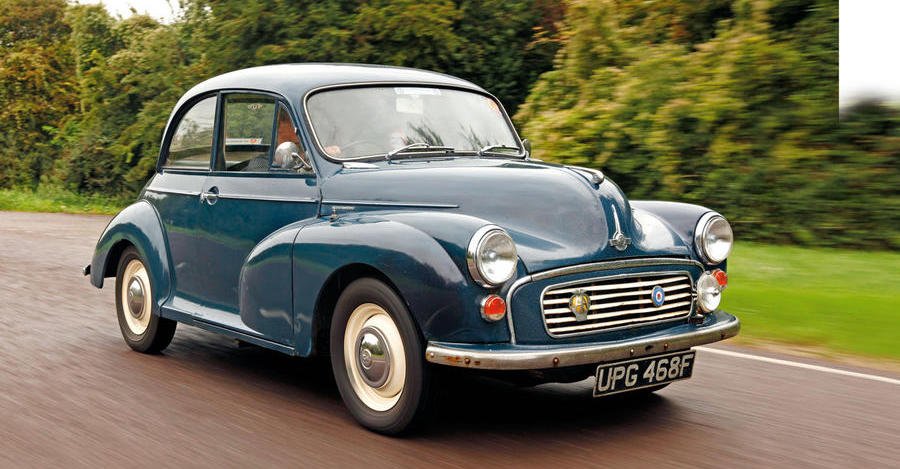Here's a small, no-frills Morris that was designed by Sir Alec Issigonis, was powered by an A-series engine, sold like hot cakes and has come to be seen as one of the most important British cars ever built. No, not that one, the other one (although confusingly the two did half-share a name for a few years).
It's easy to overlook the Minor, given the cult appeal of its smaller Mini sibling and the comparatively overwhelming global success of foreign rivals such as the Fiat 500 and Volkswagen Beetle, but strong showings in the UK sales charts and Issigonis's commitment to uncomplicated engineering mean there are plenty of clean examples at sensible prices to choose from today.
The Minor is more than worthy of consideration as a first foray into the world of classic car ownership, being relatively reliable, cheap to repair and – above all – utterly charming.
We will focus on the models built between 1952 and 1971 here, because the original MM is a bit of a different beast and prices are edging their way out of the realm of budget classic motoring. That means we have three distinct but near-identical iterations of the Minor at our disposal, each with their own unique pros and cons.
Let's begin at (or near) the start with the split-windscreen Series II. Built from 1952 to 1956, it's powered by a thunderous 803cc version of Austin's A-series engine and can zip from 0-60mph in little more than 50sec. Speed isn't a priority, obviously, but the Minor's ability to crack 30mpg wasn't unimpressive at the time, and the introduction of the wooden-backed Traveller estate and a range of commercial bodystyles took the model into new markets.
Updates for the Series III were extensive and cemented the Minor's position as an affordable, dependable runaround – a label that endures today, despite its quirks. Named the Minor 1000 in reference to its, erm, 948cc engine, it's just about capable of holding its own in today's traffic, and it comes with such luxuries as windscreen wipers that actually work and largely watertight windows.
Minor expert Richard Plant says this is the one to go for if you want to "dip your toe" into the world of classic car ownership, and with prices starting at around £3500 for a runner, you shouldn't be intimidated.
In 1962 came the Series V (the Mini-Minor having taken the Series IV badge), which upped capacity to 1098cc while gaining a stronger gearbox and bigger brakes. This later car is about as usable as they come, and a huge proportion have weathered the decades. Be aware, though, that many Minors have been owned for life and run on a budget, so a fine-tooth-comb approach is always best, irrespective of the car's age or outward appearance.
Learn what to look for, though, and you can take your pick from a huge array of convertibles, vans, two-doors, saloons and estates, any of which could be your next daily driver with the right care and attention.
How to get one in your garage
Richard Plant, Minorparts of Oxford: "A shabby original car that has just been used and well maintained can be a much better buy than one that looks shiny because somebody has painted over all the rust. If you're unsure about roadworthiness, it's always worth offering to pay the cost of an MOT certificate if the seller is prepared to take it to the garage."
Buyer beware...
- Engine: The Austin-derived side-valve engines are poor performers and have a weak bottom end, but the later A-series is peppier and more durable, particularly in its later 948cc and 1098cc guises. Head gaskets don't like hotter-burning modern fuels but valve-seat recession is rare. Some owners get an unleaded conversion or use lead additive, but others report no issues with an original unit. The fuel pump can play up, but a new one is only £100. Be more worried by burning oil than by any leakage.
- Brakes and tyres: Spend £25 on good-quality shoes rather than skimping, because the primitive braking system needs all the help it can get. The original 145/80 R14 tyres are still in production, but many owners prefer wider 155s. Tyres still age when not being used, so even a low-miler might need new rubber.
- Bodywork: Don't be put off by tatty paint; what's important is that the substructure (sills, chassis legs, door pillars etc) is fit. Minors aren't worth enough to justify huge welding bills, so walk away from a crumbling car. Reproduction panels can be poor, so get solid parts from breakers' yards. The Traveller's wood is prone to rot, but professional treatment should hold it at bay.
- Gearbox: Crunching into first is normal, because there's no synchromesh, so just take it easy. One owner reports 350,000 miles from his original gearbox, so they can last, but be sure to change the oil every 6000 miles. Reconditioned units may be as knackered as the part you're trying to replace, so get a guarantee.
- Interior: Water can invade through tired window and door seals, which is especially bad news if there's already rust beneath. Check the carpets and back seat for dampness, but don't panic, because seals are cheap and can be fitted at home. Check the few electrical components work, as corrosion can lead to poor earthing. An entire new wiring loom is only around £200.
Also worth knowing
The original recommended service interval for the Minor was 1000 miles, so being handy with the spanners will help. Consider joining your local branch of the Morris Minor Owners Club, a great resource for parts, knowledge and meet-ups. Learn how to perform the more regular maintenance jobs and the cost of ownership will plummet.

